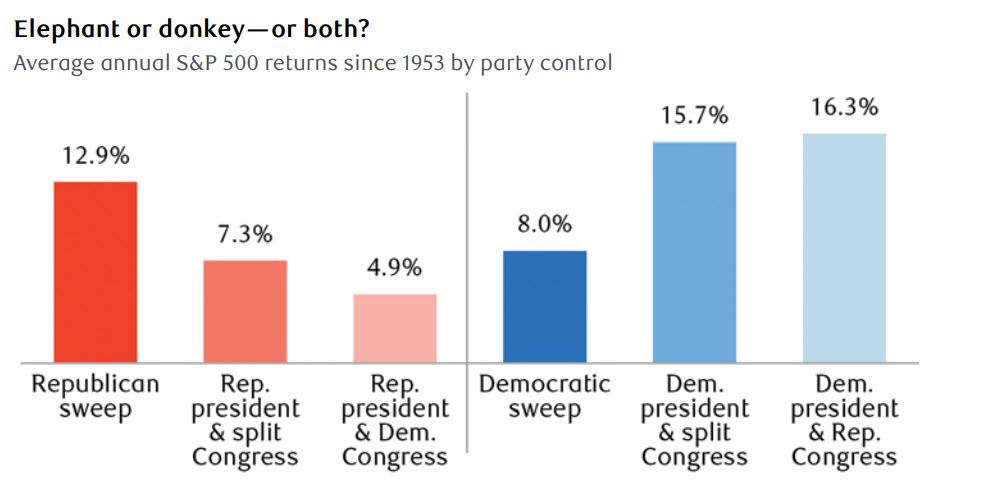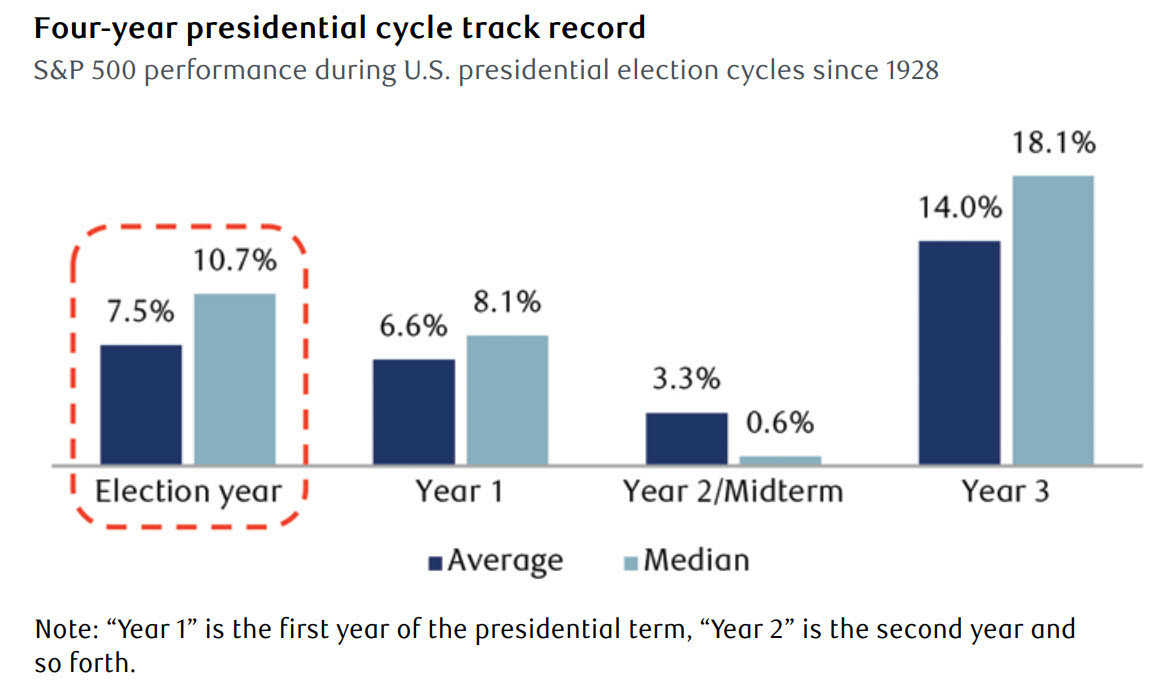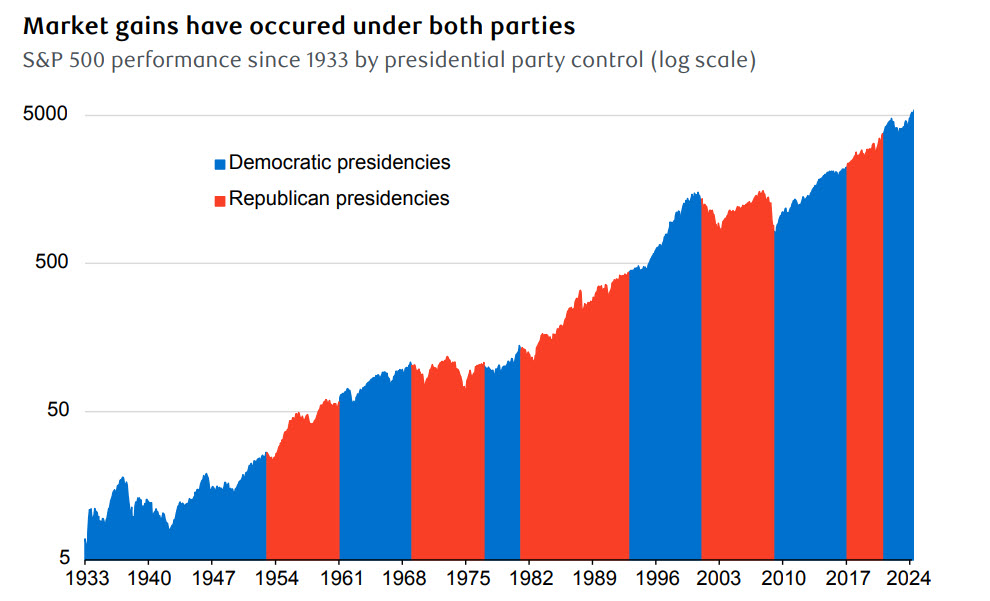Given the increased contentiousness of U.S. presidential elections, there is a growing perception that the stock market will be heavily influenced by the outcome. But a quick look at previous election cycles may offer reassuring insights for investors to focus on instead.
Over the years, the market’s strength during and after presidential elections has had less to do with who or which party occupies the White House, or which party controls the House of Representatives and Senate, and more to do with other factors. As the election approaches and campaign rhetoric fans the flames of financial worry or anxiety, keep in mind the following four key points as well as three investment fundamentals.
Key points
#1 – The market has performed well under various combinations of party control
Source - RBC Wealth Management, Bloomberg; monthly data through 8/31/24 shown on a logarithmic scale. Categories separated by inauguration dates when a party change occurred. Past performance does not guarantee future results.
The U.S. stock market has risen during Republican and Democratic presidencies—including during both controversial and noncontroversial presidencies, as illustrated on the chart. There were a couple of lengthy periods when the S&P 500 struggled, such as during the 1970s when Presidents Richard Nixon and Gerald Ford (shown in red in the chart) and Jimmy Carter (in blue) served. But by and large, from 1933 onward, the market rose during several Republican and Democratic presidential periods and substantially so at times.
#2 – Wall Street’s priorities often differ from Main Street’s

Source - RBC Wealth Management, Berg; data through 12/31/23; data based on price returns (Does not include dividends) Pas performance does not guarantee future results.
Wall Street and Main Street priorities often differ. Among the policy issues that catch Wall Street’s attention, very few end up being primary drivers of stock market or sector returns—especially long-term returns. Wall Street’s priorities, which are shown in the accompanying illustration, can differ from what large portions of the electorate prioritize. The market often ignores important social issues that help determine election outcomes. For example, this election season, various voter groups are focused on crime, border security, homelessness, the fentanyl and opioid crises, abortion, etc. But historically, social issues have had little direct, immediate or discernible impact on the corporate profit growth of large companies that make up the S&P 500, which is Wall Street’s primary focus.
#3 – The Fed, economy, innovation and profits tend to matter more than Washington policies
| Economic policy | Foreign policy | Sectors & industries |
|---|---|---|
|
|
|
Source - RBC Wealth Management
The Fed’s monetary policies have historically influenced the economy, inflation, bank lending and credit availability much more. The Fed’s decisions tend to help shape business cycle, which in turn highly influence corporate profit growth—the latter of which is the secret sauce of the stock market. Likewise, Fed policies have tended to be major determining factors of U.S. bond market performance and have increasingly influenced policies of other developed-market central banks and the performance of those bond markets.
#4 – Historical election data are useful to consider, but there are caveats

Source - RBC Wealth Management, Bloomberg; anaual data through 2023; data based on price returns (does not include dividends) Pas performance does not guarantee future results.
When dividing time into four periods—the election year, year one of the presidential term, year two of the presidential term (which is also the midterm election year) and finally year three—a persistent pattern of performance appears stretching back to 1928. The S&P 500 was strongest in year three and second strongest during the presidential election year (see the four-year presidential cycle chart). Political pundits and market strategists have their theories as to why this four-year pattern has persisted—some of which involve higher federal spending in year three and some data point to Fed policy patterns in the various years.
Historical trends show that the stock market and investments should remain stable regardless of the election outcomes. |
Focus on the bigger picture
Regardless of your personal point of view about the economic and investment prospects, instead of counting on historical trends or listening to campaign rhetoric that may fade soon after the election, you may feel more confident in your investment decision-making when you consider the following three investment fundamentals.
1. Diversification—By spreading your dollars among various equities, fixed income securities, cash accounts, alternative investments and other vehicles, you can help reduce the effects of market volatility on your portfolio.
2. Asset allocation—Allocate your investment portfolio appropriately for your long-term goals while maintaining a suitable cash position for your short-term financial goals and liquidity needs.
3. Tax management—A tax-smart move is to contribute to tax-advantaged retirement accounts, such as your 401(k) and IRA.
Presidents and politicians come and go, as does their impact on the financial markets. So, when you “vote” with your portfolio by making investment decisions, choose wisely and stick to the fundamentals of investing because no one has greater control over your success than you. And, of course, work with your financial advisor for guidance and advice.

